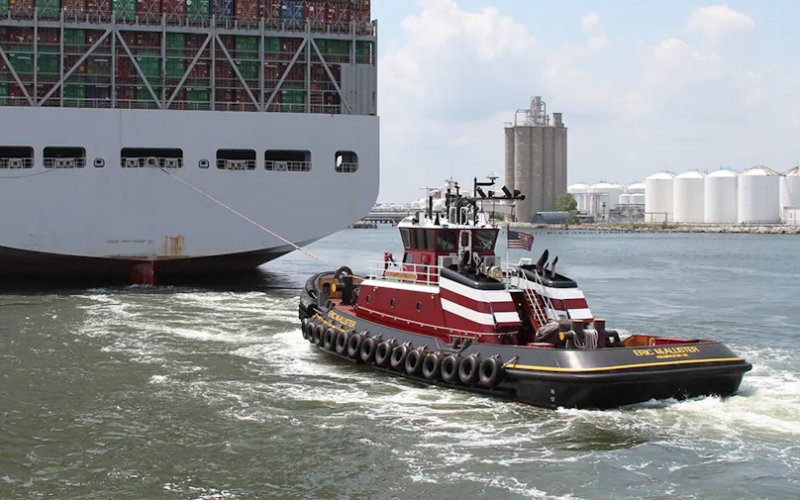The head of the trade group representing the tug and barge industry says it’s premature to conclude that changing protocols for tug escorts or standardizing escort rules in all ports across the country is necessary in the aftermath of the container ship accident last week that caused the collapse of a highway bridge in Baltimore, killing six people.
Many maritime experts have suggested that if the two tug escorts from McAllister Towing and Transportation had stayed with the 95,000 gt. Dali cargo vessel until it cleared the Francis Scott Key Bridge during the early hours of March 26, the accident might have been prevented or the bridge damage lessened.
Two Maryland harbor pilots were temporarily in charge of navigating the massive Singapore-flagged vessel on its exit from the Port of Baltimore to continue its voyage to Sri Lanka. The Bridget McAllister and Eric McAllister, experienced tractor tugs with McAllister, guided the Dali out of the dock and then left the ship when it was safely inside the channel. Soon after, the ship lost power and began to drift outside the channel toward the bridge. Minutes before hitting one of the bridge supports, the pilot radioed the tugs for help, according to an early review of the ship’s data recorder by the National Transportation Safety Board, which is investigating the accident.
The Port of Baltimore, which is operated by the state of Maryland, requires tugs to assist vessels in and out of port but doesn’t require extended escorts into the port’s channel or further into the Chesapeake Bay. Harbor pilots, the Coast Guard or the shipping company can request extra tug services, however, if they have concerns about things like safety, maritime traffic or weather.
Jennifer Carpenter, president and CEO of the American Waterways Operators, which represents the towing and barge industry, expects that the federal inquiry that will result from the accident will explore the tug escort issue.
“It will be examined because everything will be looked at, from why did the ship lose power, to safety management systems and preventive maintenance, bridge protections and tug assistance and escort,” she said. “We should look at all those things.”
But, she added, “let’s undertake the analysis in a careful, thoughtful, serious way. We know tugs are tiny and mighty and can do a lot of things to facilitate maritime commerce and safety, but at the same time it’s important to avoid speculating on how this could have happened.”
She said her industry’s message is, “tugboats can do a lot of good, but we should avoid a rush to judgement that tugboat escorts are the answer everywhere.” There are many other factors to consider in whether to upgrade tug escort requirements, such as a port’s potential safety risks and operational conditions, the types of cargo being handled and typical size of calling vessels, a port’s geographic location and configuration, and whether the risks of a catastrophic incident justify the extra costs to shippers.
Under the OPA90 law that passed after the 1989 Exxon Valdez oil spill in Alaska, tug escorts were required for oil tankers transiting Puget Sound and Prince William Sound, Carpenter said. The law directed the Coast Guard to look at escort rules in other areas, and the Service concluded that any escort changes should be specific to the needs of a particular port. “We think that is an appropriate” approach, she said. Imposing a national, uniform escort requirement on all ports, she said could create many negative consequences: increased port fees for shippers and more complications for port operations with more vessels to manage, more pollution from increased vessel traffic and implications for safety and efficiency of maritime transportation.
“There are many questions that have to be answered” before jumping on escort tugs as a solution, she said. “We must ask what do we want the tugs to do, what is the added margin of safety that they will provide? What size and capacity should they be? Tug escort is a complicated maneuver. Where will the crews be trained?”
There’s a lot that goes into doing this right, Carpenter cautioned. “We should look at this carefully because we don’t want to say we solved the problem, but we haven’t really done the hard work of determining what’s going to make a difference here.
“But we welcome that inquiry,” she said, “and we look forward to being a constructive part of it.”
Meanwhile, Carpenter said she expects tug and barge companies in the Baltimore area will be active participants in the Key Bridge accident recovery and channel-clearing work.
Contractors are working around the clock and have removed the first piece of the bridge wreckage — a 200-ton piece — that had blocked entry to the port. On Monday, a temporary, shallow-draft channel was opened that is allowing smaller vessels to enter and exit the port, including some tug and barge companies that had vessels stuck in the port, she said.
The federal government on Thursday awarded Maryland an initial $60 million for mobilization, operations and debris recovery, and the Navy has sent four heavy-lift cranes to assist.




